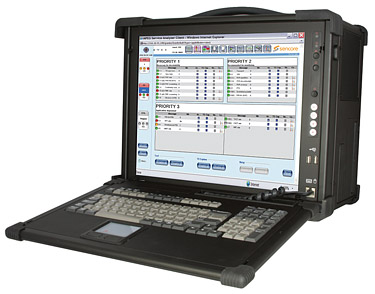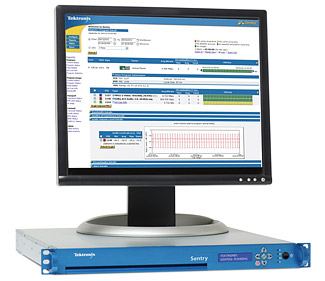The Challenges of Monitoring Video Over IP
OTTAWA—By now, we all know that encoding video into digital data packets, and then transporting those packets over conventional TCP/IP networks, is a cost-effective alternative to using dedicated video channels over landlines and/or satellites. This is why NBC used a Cisco-built IP-based "medianet" during the 2010 Vancouver Winter Games to transport all of its coverage, which allowed NBC New York personnel to receive and edit live Olympic video content in real-time, while costing less to use than dedicated video telecom channels.

Sencore MSA1850 MPEG Service Analyzer Janne Morstol, chief operating officer for T-VIPS, a Norwegian-based provider of signal monitoring and processing technology notes the rapid progress of video over IP just over the past five years. "When we first entered the U.S. market in 2007, it was truly 'early days' for video over IP," she said. "Times have changed. We are seeing many broadcasters realizing the advantages of this form of transport, and moving to it."
Add the fact that broadcasters are consolidating their back office operations on IP-based networks, and it makes sense for them to embrace video over IP. However, the technology's intrinsic design comes with built-in challenges that must be monitored and managed to ensure continuous, uninterrupted video feeds.
TCP/IP'S BASIC FLAW
Short for Transmission Control Protocol/Internet Protocol, TCP/IP defines the rules by which data is sent over a computer network. It does this by gathering groups of data into virtual containers known as packets, which are shipped down the network as soon as they are full.
Danny Wilson president of CEO of Singapore-based Pixelmetrix Corp., which manufactures test and measurement gear, compares the TCP/IP packet to a bus. "This bus will only leave when it is full," he said. "Once it is full, the packet heads down the line to the receiving end. But until every seat is taken, that bus is going nowhere."
This inconvenient aspect of TCP/IP introduces latency, which doesn't pose a problem to data, but can result in interruptions in video and other continuous feeds. Add delays caused by multiple TCP/IP "hops"—as the data is routed through various servers around the world—and latency issues only become worse.

Danny Wilson, president, Pixelmetrix There are two ways to deal with TCP/IP latency. The first is to use a buffer at the receiving end, which collects packets, delaying the start of playback until there are enough in storage to compensate for any latency issues. The second method involves reducing the number of hops by using the most direct TVP/IP pathway between the transmission and receive sites. If this pathway provides priority access for the video feed, so much the better. The video packets won't end up sitting on a virtual siding, waiting for someone else's data to go by.
"We call these processes 'bitrate smoothing or traffic shaping'," says Wilson. "They ensure that the video being accessed at the receiving end is continuous."
MONITORING IP
Pixelmetrix helps broadcasters get the most from video over IP, through the company's Consolidator enterprise grade network management platform. Consolidator keeps a close eye on the entire video over IP chain, while giving operators a simple single-screen view into their network's performance and problems. "We cover the entire system from end to end," Wilson said. "This ensures that your video over IP system is operating optimally, all of the time."
Sioux Falls, S.D.-based Sencore also provides software products that monitor, manage and troubleshoot video over IP networks. "Our goal is to help you find out fast whether the problems are in your IP transport stream or your MPEG video feed," says Seth VerMulm, Sencore's product manager for signal quality. "This lets you get on top of issues before they become serious, and deal with them promptly."

Tektronix Sentry German test and measurement company Rhode & Schwarz recently introduced DVMS1 and DVMS4 low-cost (under $8,000) transport stream (TS) analyzers to monitor MPEG transport streams. "Using internal demodulators R&S MPEG analyzers can conveniently compare pre- and post-modulated content to ensure that MPEG payloads are fully intact," says Greg Kregoski, business development manager, audio/video test with Rhode & Schwarz USA. "In addition to these types of features, both the DVMS1 and DVMS4 support SNMP for easy integration into an overall monitoring system."
Tektronix's "Sentry" monitoring system automatically analyzes hundreds of streams at both the transport and content levels. "The most common monitoring points are immediately after any video/audio process such as encoding, transcoding, multiplexing, rate-shaping, grooming, and ad insertion/splicing," says Steve Liu, Tektronix's vice president of video network monitoring, in Beaverton, Ore. "Sentry now enables operators/broadcasters to cost effectively monitor all streams in real time 24x7, therefore significantly reduce mean time to detection and repair of the most common consumer impacting issues."
T-VIPS, a pioneer in the field of video over IP transport management and monitoring, offers a complete range of products, including applications for video over IP gateways (content contribution and distribution covering many locations), processing and multiplexing, and signal switching. "Our systems support JPEG2000 encoding, which provides superior video quality over IP and virtually no artifacts at high bit rates," says Janne Morstol.
As the world migrates to TCP/IP in all industries, it seems safe to say that broadcasters will eventually move all of their video over IP networks. "After all, more is spent on R&D for general IT and telecom than on the entire global broadcast industry," Wilson observes. "So it only makes sense to move to a platform that benefits from ongoing advances and huge economies of scale, which proprietary broadcast-only transport solutions simply can't match."
This said, latency and network performance remain issues that must be monitored when using video over IP transport. Broadcasters who do not take precautions by deploying monitoring solutions such as those listed above, are literally gambling with their livelihoods.
The professional video industry's #1 source for news, trends and product and tech information. Sign up below.
James Careless is an award-winning journalist who has written for TV Technology since the 1990s. He has covered HDTV from the days of the six competing HDTV formats that led to the 1993 Grand Alliance, and onwards through ATSC 3.0 and OTT. He also writes for Radio World, along with other publications in aerospace, defense, public safety, streaming media, plus the amusement park industry for something different.

